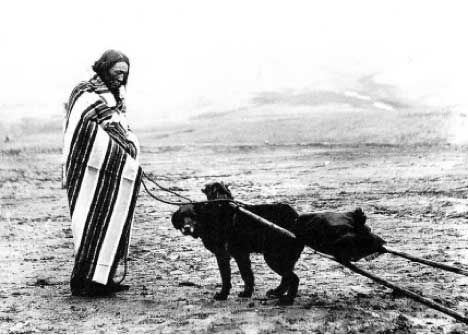Dogs are the true mystery
A bull bison is dangerous, a bear is dangerous, a wolf is dangerous, but nothing in the ancient world was as dangerous as a dozen men armed with spears and the skill and organization to use them correctly.
Wolves differed from the bears and the bison in that they could adapt to men, and what they had in common with our species is that they were also a keystone species. Recently wolves were released into a valley in Yellowstone Park and what happened as a result surprised even naturalists. The wolves changed the valley in fundamental ways, they changed the flora, the fauna, and they even altered the course of the river. It was long assumed that a beaver was a classic example of a keystone species, because the beaver pond had a huge impact on lots of other animals besides beavers. But the Yellowstone experiment indicated that wolves were not only a keystone species but the preeminent keystone species of the American West, until we came.
We know that dogs came from now extinct wolf ancestors, but when men first arrived in North America they did not domesticate the wolf, because they already had domesticated wolves with them—dogs. These dogs were descended from a long extinct wolf species, and they may have been domesticated more than once, in different places, from more than one wolf species, and at different times in history. But whatever the case, dogs diverged from their wolf ancestor. Although their overall intelligence dropped, their emotional intelligence skyrocketed, their ability to read human actions and expressions, and their instinctive pack need for companionship and cooperation, made them the ideal candidate for domestication. Long ago a man walked the hinterlands of Central Asia, and realized the wolf-looking dog beside him was his best friend.
It is hard to say when this ancient bond formed, but DNA analysis of dogs indicates it was long before civilization took hold, and there are even those who assert our pre-human ancestor, Homo Erectus, had companion dogs.
When the Europeans arrived in the New World, they brought dogs, and the tribes that they encountered all had dogs, so other than men, dogs were the only species present in both groups. The Europeans did not find horses, even though horses had evolved in North America, because the ancient horse had migrated west across the Bering Strait land bridge, where they thrived, long before human beings ever existed, and then the parent species died out back in North America.
But wolves must have been domesticated somewhere in Central Asia and the European dogs followed their masters to the west, and the North American dogs followed their masters to the east. To the south, dogs were island hopping along with their sea faring Polynesian masters, eventually reaching Rapa Nui, or Easter Island, and from there leap frogging to the South American coast.
However modern dogs got to be where they are, they are all closely related because they can all mate, even a Chihuahua and a Great Dane can mate, and despite the immense differences in size and appearance, those differences are the result of just a few tweaked genes.
Because tribes did not have the horse, the dog became their only option for horse-power. Far to the north, dog-powered sleds gave the Inuit incredible mobility in a harsh environment. Dog-drawn travois relieved the Lakota of a lot of burdens. The extent of how much dogs helped the Lakota has been lost to history, but we do know they served great utility as scouts and watchdogs, and sentries to alert the tiospaye to danger. A dog’s eyes are filled with rods which indicate he has excellent night vision. He cannot see in the fine detail humans can, but he tracks movement much better, and that humans use dog whistles, emitting a whistle humans can’t hear, indicates how much better his hearing is.
But what most separates a dog from humans is his olfactory. His sense of smell is up to 100,000 times more acute than our own. You see a dog bolt down meat chunks without tasting them. That is because he tasted them, perhaps better than we can taste them, long before they ever got into his mouth, hence the overflow of saliva when he anticipates food.
The dog has diverged from his wolf ancestors, most noticeably by the drooping of his ears. But dogs bark, wolfs don’t, even though dogs can still howl like wolves. Dogs run like horses, placing their hind feet between their forelegs, but wolves lope, moving the front and back legs back and forth in unison.
Scientists don’t know the exact reasons why these changes have happened, dogs can be very mysterious as their ancient genes express themselves in unexpected ways. When the Lakota first saw the horse, they called him Shunka Wakan, Mysterious Dog, indicating two things. They had never seen the horse, he was a mystery to them, and they well knew the dog, which is why the horse was named after him.
From a utility standpoint, the horse replaced the dog. He could carry more, he could pull more, and you could ride him. But today, the rez dog still remains, so much so a TV Series about people is called Reservation Dogs. The horse is gone from most of our lives, and the true mystery was never the horse, but the dog: why we love him so, and why he is so keen to love us back.
(Contact James Giago Davies at skindiesel@msn.com)
The post Dogs are the true mystery first appeared on Native Sun News Today.

